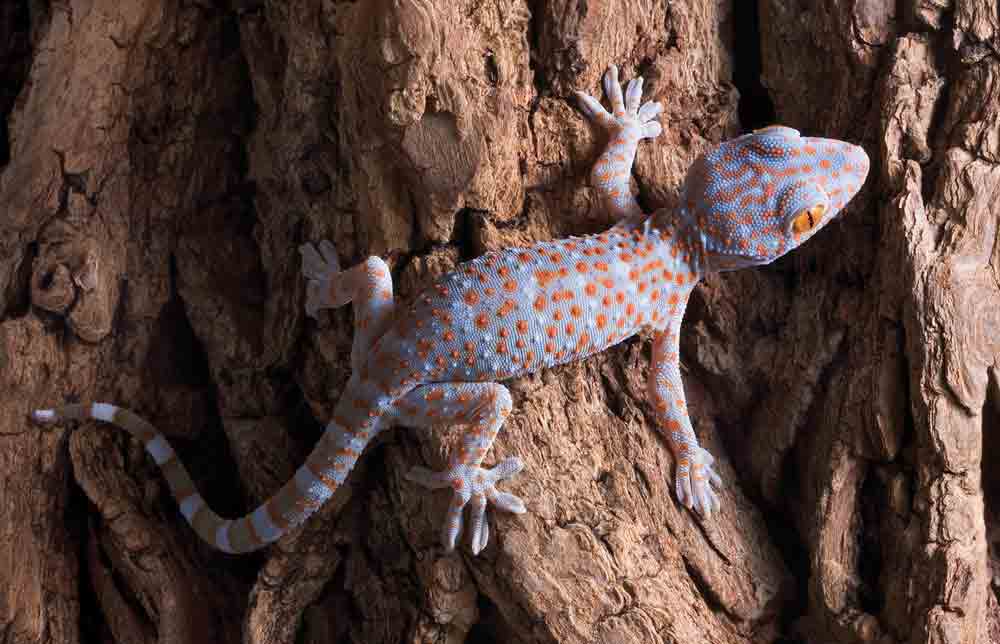Tokay geckos have many qualities that make them ideal candidates for your next scaly pet. They can be extremely hardy as long as a few fairly simple conditions are met.
Gekko gecko, commonly known as the tokay gecko, is naturally found in and all over Asia and Southeast Asia. It has also been established as an invasive species in south Florida. Tokay geckos are a large species of gecko that typically reaches 12” in captivity. They are nocturnal by nature and most active after the lights go out. While tokay geckos have always been readily available, there has been an increased interest and considerable hype in keeping tokay geckos in recent years. One of the reasons why tokay geckos have become increasingly popular with reptile enthusiasts is due to the fact they are relatively hardy if their needs are met and they also come in a myriad of colors and mutations, with some color mutations fetching rather high price tags. Many of these morphs have slowly become more readily available in recent years, however many of these are still wild caught imports. Needless to say the establishment of tokay morphs in captivity is still in its infancy.
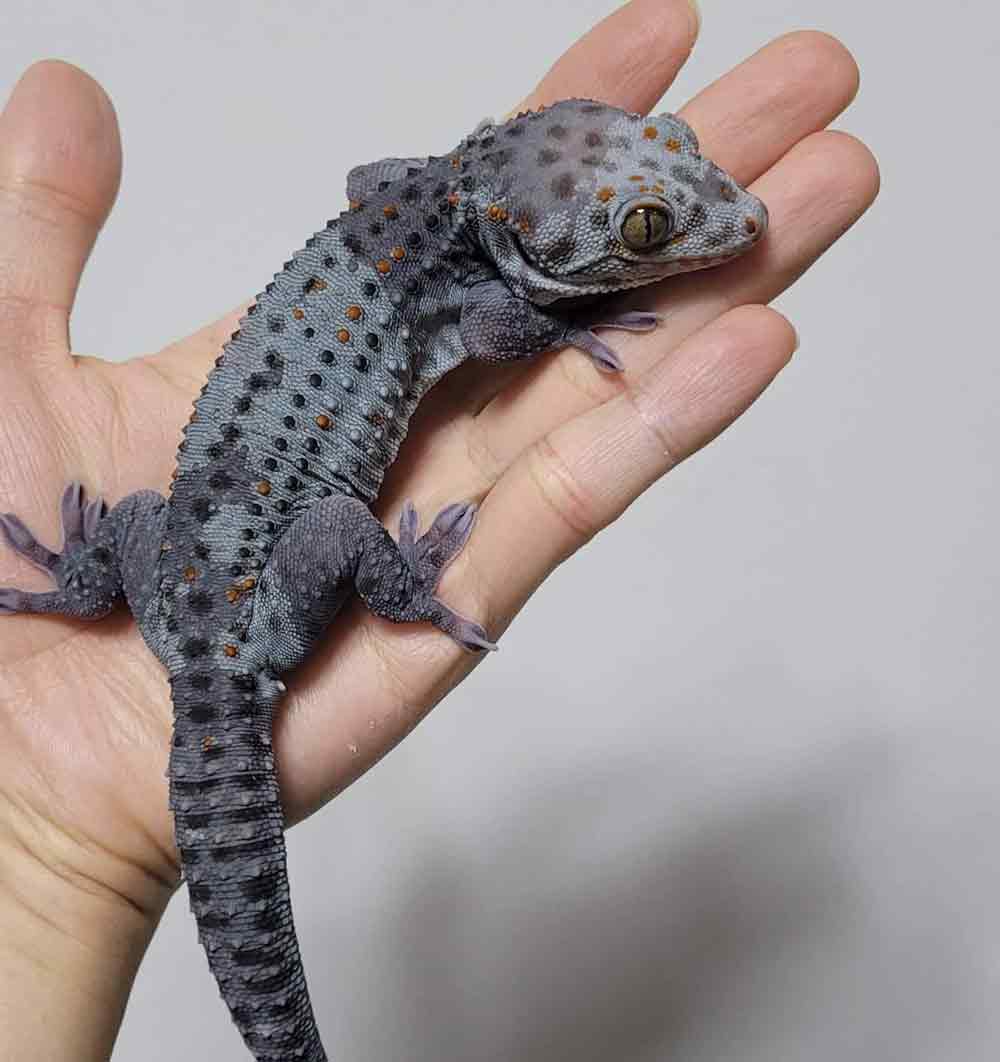
Tokay gecko ghost morph. Photo by Park Wooram
Tokay Gecko Care and Husbandry
Enclosure Requirements
Enclosures that hold heat and humidity well are required to house a tokay gecko. We use a combination of PVC enclosures, glass enclosures with an appropriately modified top, and front opening glass cages. A 18” W x 18” L x 24” H or equivalent would be the minimum size to house a pair of adult tokays. If you can afford to offer more space, go for it! Keep in mind that tokay geckos can get to 12”, sometimes even bigger, and the bigger the enclosure one can offer the better. Upgrade to a larger enclosure as they grow larger. Tubs and rack systems using tubs are not good for this species. Make sure to include multiple hiding places for your tokays. Cork tubes, cork panels, PVC tubes, and other reptile hides are good hiding places for your gecko. If you are using any type of tubing or tube, make sure that your hands can fit inside. Otherwise it will be quite challenging when it comes time to remove the gecko or its babies if they are hiding in a narrow tube. While juveniles of both sexes and similar sizes can be housed together without too much trouble, adults should be housed individually or in sexed male female pairs. Do not house two adult males together, as that will most likely result in one male being harassed and stressed out.
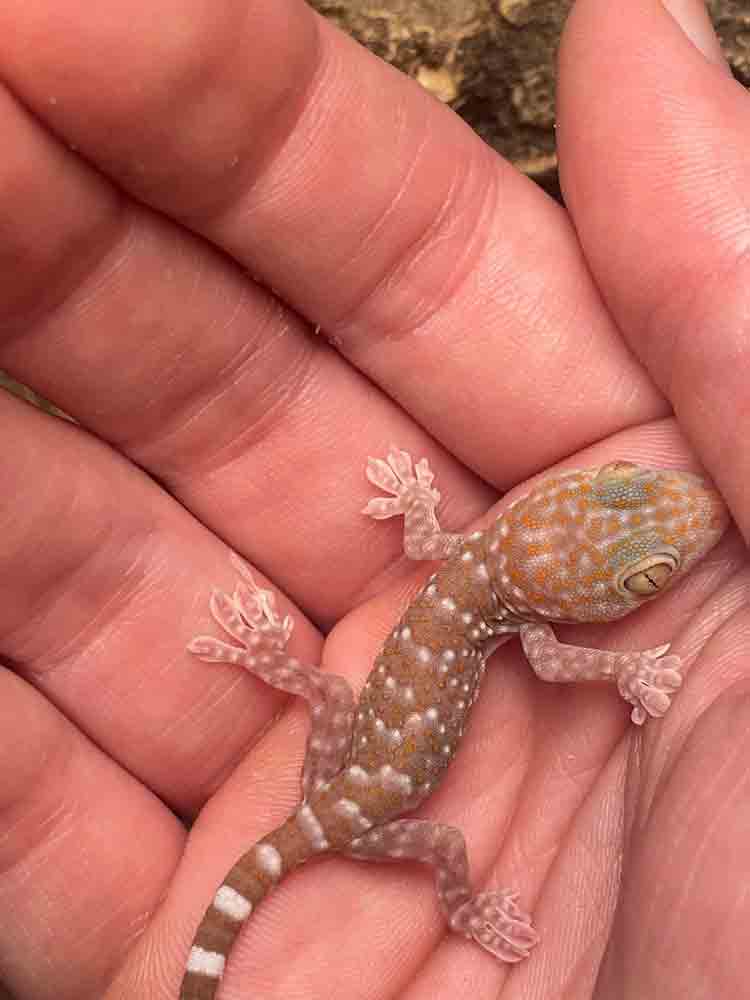
T+ baby Tokay gecko. Photo by Joshua Carson
Ideal Lighting/ Temperature/ Humidity for Tokay Geckos
Tokay geckos are native to tropical environments. Here at Gekko & Gecko, we have found it easier to heat the entire room versus heating individual cages. Ambient temperatures range from 80 to 90 degrees Fahrenheit (26.7 to 32.2 degrees Celsius) depending on the season, but the average would be around 84 degrees Fahrenheit (28.9 degrees Celsius). A night time temperature drop is provided and temperatures drop down to 75 to 78 degrees Fahrenheit (23.9 to 25.6 degrees Celsius) depending on the time of day and season. Ideal humidity ranges from 50 to 60%. They should be maintained in a relatively humid environment but be mindful that this does not mean that the enclosure is wet all the time. If the humidity is too low, you risk potentially having stuck sheds. Keep in mind the geckos do not like their cage to be wet and soggy. In fact, we have found that when the substrate is too wet, they tend to stop eating and be less active. Light is provided with a 12 hour on/off cycle. We do not use any special bulbs and have not had any issues thus far. Being that they are mostly nocturnal, tokays are usually hiding most of the day when the lights are on. It is up in the air on whether or not having access to UVB is beneficial. Being that they are mostly nocturnal, tokays are usually hiding most of the day when the lights are on. However, some breeders do provide UVB to their tokays. They have reported seeing positive results with using UVB especially with breeding females. Currently we are providing all breeding pairs here at Gekko & Gecko with access to UVB.
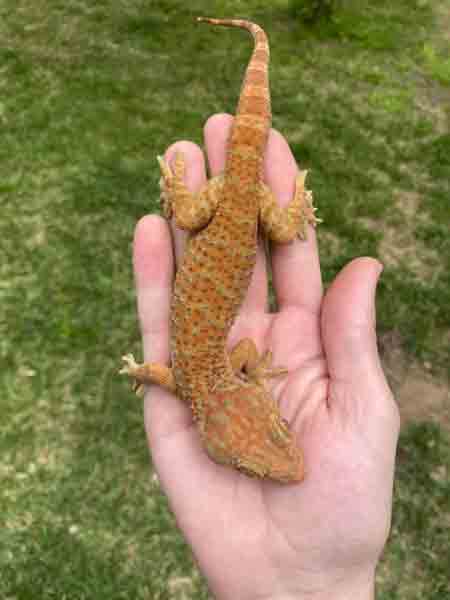
Super red morph. Photo by Joshua Carson
Tokay Gecko Feeding
Tokay geckos are opportunistic feeders, meaning that they will go for almost any insect or small mammal that will fit into their mouth. In captivity, crickets and dubia roaches make up the bulk of their diet. Superworms and hornworms, if they will take them, are great ways to get some weight on skinnier geckos. Make sure that insects are gut-loaded and dusted with a high-quality vitamin and calcium powder. Some tokays might even take an occasional pinky mouse. Feed about two to three times a week. Watch the weight of your tokays, some animals especially males tend to “pack on the pounds” very quickly and develop “rolls” on their sides. As with other species, an obese tokay gecko is not a healthy animal and will not be a great breeder.
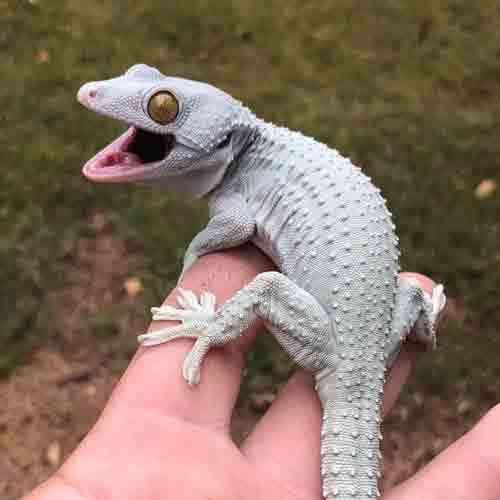
Power blue morph. Photo by Mark Prieto
Handling the Tokay Gecko
Tokay geckos are not naturally tame or easy to handle like many other geckos. Animals that are not used to handling will not hesitate to bite. A bite from a tokay gecko can be quite painful and cause bleeding. More often than not, once a tokay gecko has clamped its jaws onto you, it will be reluctant to let go and the more you struggle or try to get them to let go, the harder they will clamp down. That being said, taming a tokay gecko is not impossible. One of the first steps in taming a tokay would be to get the animal to accept food from tongs. This becomes an important first step in building a bond and trust with your tokay. It is important to remember that tokay’s are defensive, and not aggressive like most people think. Once the keeper understands this, taming and keeping will become easier.
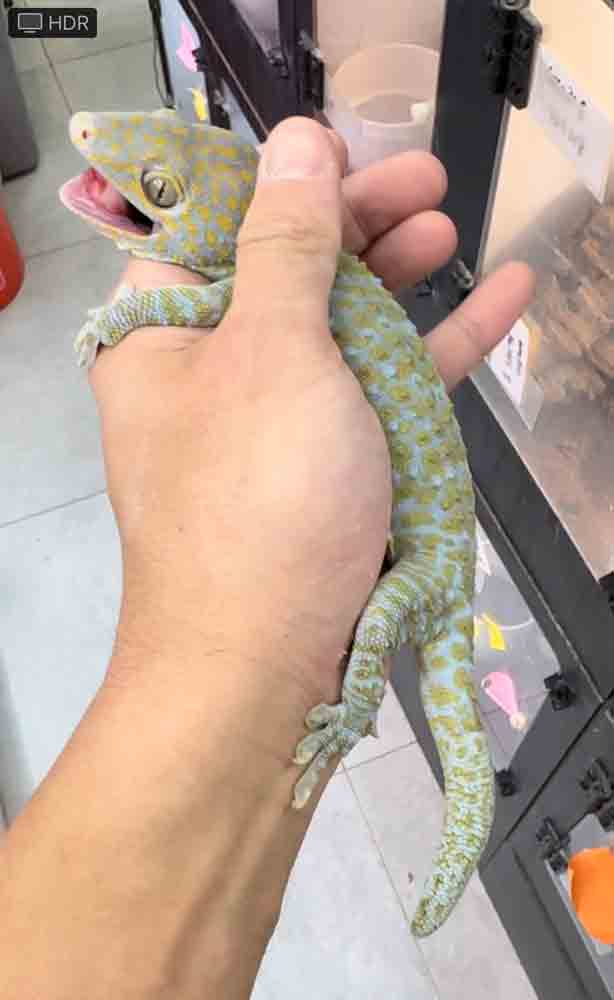
Platinum morph. Photo by Jimmy Ma
Wild Caught versus Captive Bred
As with most reptiles, a captive born and bred animal would be the ideal first tokay gecko. However, the majority of tokay geckos available are still going to be wild caught individuals that are imported from either Indonesia or south Florida. A healthy tokay is usually very alert, active, and oftentimes, angry!
The most important thing if you are starting with a wild caught animal is to get it hydrated and eating. Many times imported animals have had an extended period of time sitting in a holding cage in less than ideal conditions. By the time they get to you, they may be severely dehydrated and emaciated. Hold off on deworming or any other parasite treatment until the animal has been eating and is hydrated properly. More often than not, an animal is skinny due to negligent care rather than parasites. If an animal that is dehydrated and emaciated is treated for parasites, their bodies might not be able to handle the medication and the resulting increased strain on the body of removing the dead parasites. We suggest waiting until the animal is stable and of decent body weight before doing any treatment. Consult with a veterinarian for a fecal sample and proper dosing of medications such as Flagyl and Panacur. The issue of parasites and dehydrated and emaciated tokay geckos can be lessened by seeking out a captive-bred tokay gecko from a reputable breeder. Captive-bred should always be the first choice.
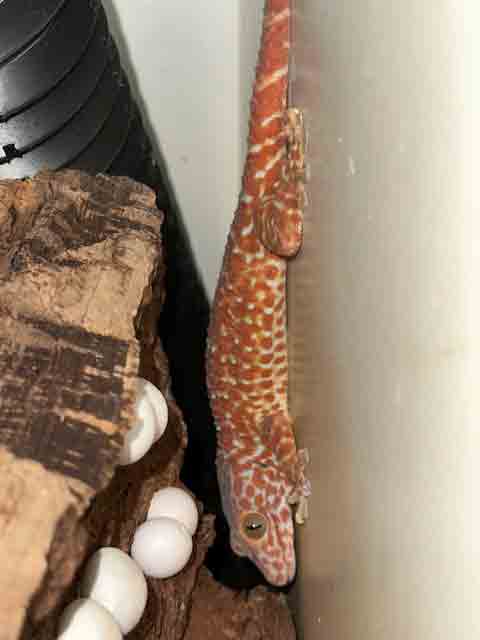
Super red guarding eggs. Photo by Jimmy Ma
Breeding the Tokay Gecko
Tokay geckos are one of the few geckos that provide parental care for their young. Pairs will guard their nest, eggs, and babies ferociously. It is not uncommon to even have pairs tending a nest that consists of babies and juveniles of varying ages and sizes. Sometimes you will even see freshly hatched babies eating the feces of the adults as their first meal to help get their stomach started. Tokays reach maturity at around 2 to 3 years of age and can be considered for breeding if they have good body weight, usually around 90 grams. This is especially important for females. In order to breed tokays, you need to make sure that you have an accurately sexed pair. Both males and females will display femoral pores. Adult males will have much larger, waxy pores that are rough to the touch. Female tokays have more defined pores that will be smooth to the touch. Males will get larger and have larger head structure. Males are also the ones that will make the classic “toke-kay” call.
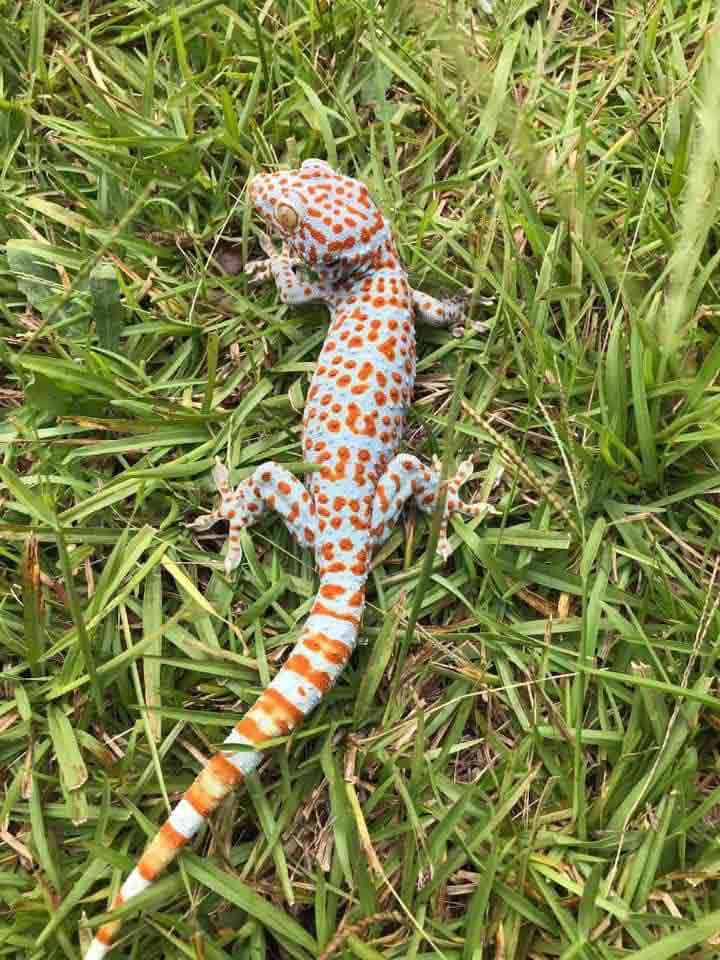
Normal. Photo by Joshua Carson
In order to successfully breed tokays, it is important to make sure that your pair is compatible. Not all pairs are. This is similar to what happens with the New Caledonian giant geckos (Rhacodactylus leachianus). Some animals are just not compatible and as a result they will not breed. One sign that two animals are compatible is if they “sleep” together in the same tube or hiding space.
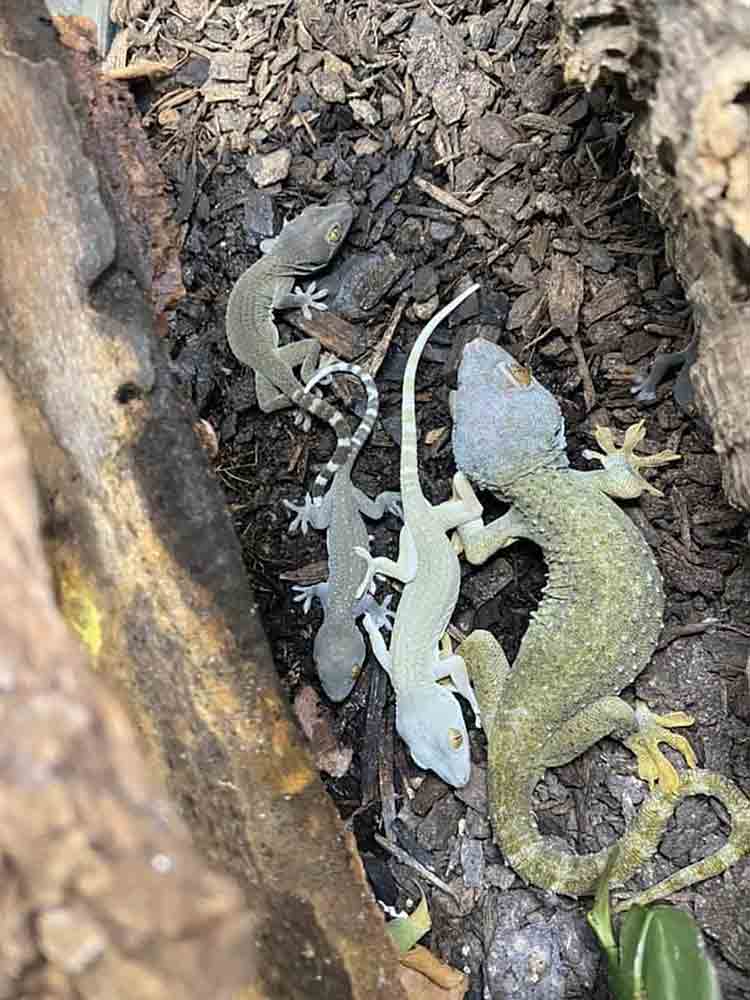
Tokay geckos protect their babies for significant amounts of time.
If your animals are compatible, they will lay two hard shelled eggs that are adhered to either the wall of the enclosure or the walls of their chosen nesting site. The pair will continue to lay two eggs every month or so, sometimes having as many as 20 eggs in a season. It is highly recommended to remove the male after the fourth clutch or eighth egg, to reduce chances of over breeding the female. Eggs can be left where they are laid assuming the ambient temperature and humidity levels are appropriate. Incubation times can range from 60 to as many as 180 days. Something to be cautious of is the condition of the female throughout this process, especially wild-caught females. They are susceptible to crashing due to either the increased calcium demands and/or strain on their potentially damaged kidneys from when they were imported. Keep a close eye and be prepared to pull the female from breeding at the first sign that the female is losing any significant weight or acting differently.
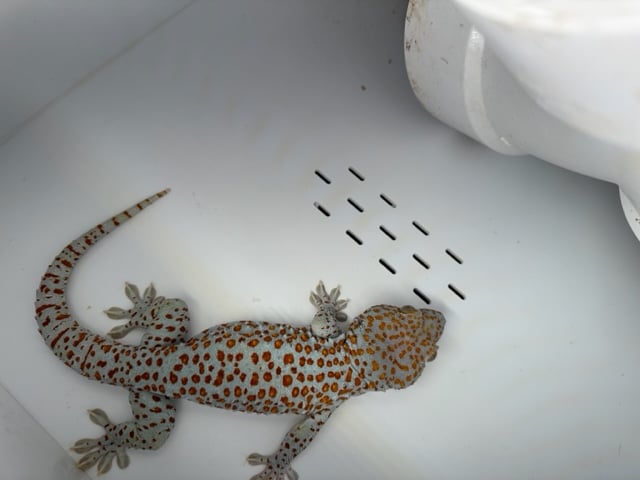
Normal tokay gecko coloration. Photo by Jimmy Ma
Tokay Gecko Genetics and Morphs
The following is just a sample of the morphs that are available in the US market. Many of the morphs have actually been known to the reptile hobby for quite some time now. However, it is only recently that some of these morphs have been proven heritable and we now have a better understanding of how tokay genetics works. We have by no means unlocked all the secrets of tokay genetics. There remain many mysteries left to be solved in the world of tokay morphs. One of the biggest challenges of tokay genetics is the fact that two animals that are phenotypically identical can be incompatible genetically with each other. Keepers in Asia seem to have made much more progress in establishing tokay morphs in captivity. It is also worth mentioning that how a tokay gecko looks is quite dependent on the external conditions such as temperature and humidity, but also the mood of the gecko itself. You would be amazed at how drastically different a tokay gecko looks when it is “fired up.”
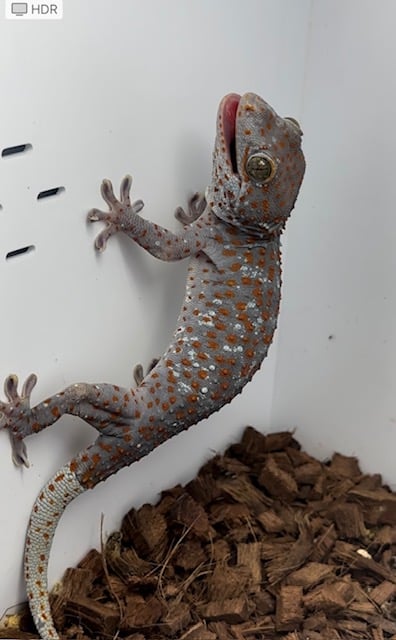
Lavender paradox tokay gecko. Photo by Jimmy Ma
Patternless: Patternless is characterized by the absence of any of the typical red patterning seen in normal tokays. Body color is usually one color and there is no evidence of two-toned banding often seen in normal tokays. There are three different forms of this mutation: blue-headed green, olive/emerald, and everybody’s favorite, powder blue. All can be combined together and produce the others. The patternless gene is a simple recessive gene. This morph is well established in the hobby and is a readily available morph.
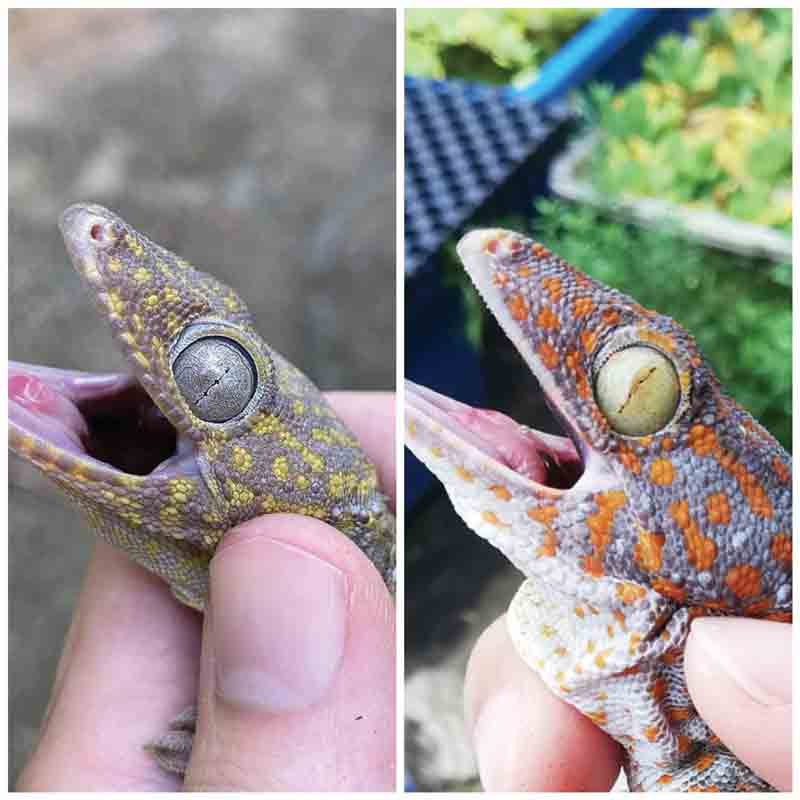
Eye color comparison. Photo by Joshua Carson
Platinum: Platinum is a morph first proven and established here in the USA by Joshua Carson of CPX Reptiles. This morph is a proven line of yellow spotted tokay geckos that is characterized by their silvery platinum looking eyes. This is a simple recessive mutation. One of the difficulties of working with tokay morphs is the fact that two animals that are phenotypically similar will prove incompatible and produce normal looking possibly double heterozygous animals. Many Indonesian exporters now use the term “Platinum” to describe any yellow spotted animals. However not all yellow spotted tokays are compatible or even heritable for that matter. There is at least one other line of proven yellow spotted tokays here in the US but time is still needed to determine whether the lines are compatible with each other.
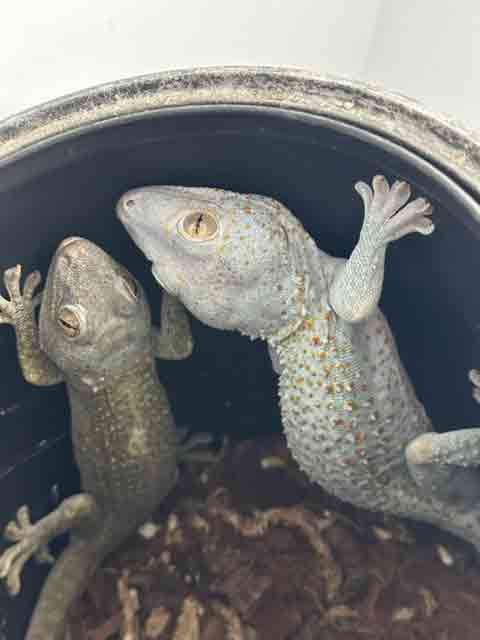
A pair of green galaxy tokay geckos. Photo by Jimmy Ma
Super Red: The super red is a co-dominant morph. Animals are characterized by an almost reversal of the normal color of a tokay gecko. The red spots on what would be normal tokay gradually gets larger and larger until it spreads out, becoming the dominant color of the animal. These tend to be a slower growing morph that ends up being a bit larger than other morphs. They also seem to lay larger eggs. Babies hatch out similar to normal tokays, but becoming increasingly more red as they get older. This is one of the most sought after morphs.
Candy Dot: A unique morph in which all the dots of the tokay are pin points and lined up straight down the tokay’s back, with a unique base tone that can make the gecko super dark or super light depending on its mood. Candy dots or candy buttons have solid black eyes. This morph is simple recessive and is quite impressive.
Lavender Paradox: The paradox is characterized by animals that have a pattern similar to that of the candy dot but more irregular. They tend to have an overall lavender or purple gray body color. Spread throughout the body randomly will be lighter contrasting, light blue patches. There is some speculation that this morph is related to the candy dot, possibly being a visual heterozygous carrier for the candy dot gene. More time would be needed to prove this out. Max Ong in Malaysia has proven this morph to be inherited as a simple recessive. Jimmy Ma was able to prove that this trait is heritable here in the USA, producing babies of this morph from two visual parents. It is unknown if the two lines are compatible but speculation is that they are the same morph.
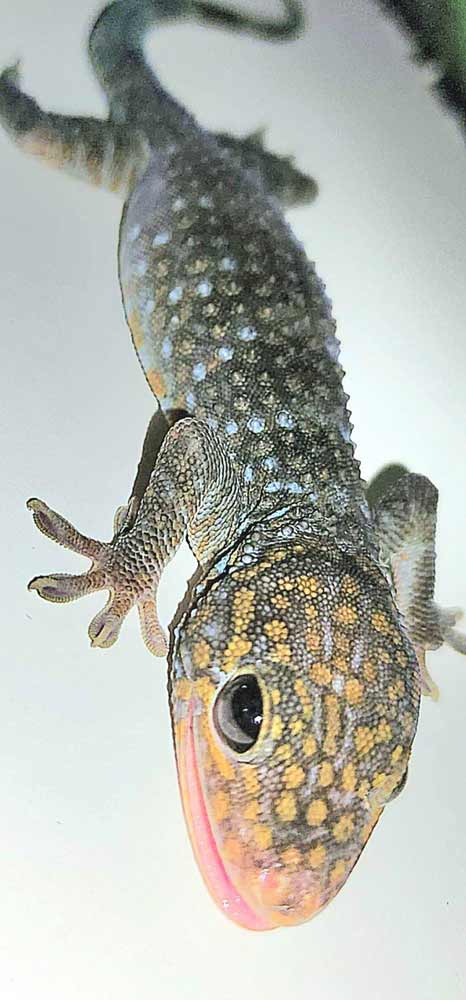
Diablo morph. Photo by Logan Barrett
Blueberry: A simple recessive morph that has slowly been making its way into the USA, in my opinion one of the coolest morphs out there and hopefully will take off once a little more production happens. Blueberry animals are characterized by having black splotches on their feet, also lacking large red spots. This morph was also proven out by Max Ong.
Ghost: Ghost is one of the awesome morphs that sadly has been eluding the US hobby for some time now, although it looks very similar to a blueberry, instead of just having black splotches on its feet it can have them all over its body, as well as having more spotting. Hopefully a few of these will make their way to the USA soon. Also another simple recessive morph, proven out by Park Wooram.
Granite/Pied/Lucy: The morphs everyone wants to produce and yet everyone seems to fail at producing, unless you are Denise Whitney at Lucky Foot Geckos. She has done some of the most work out of anyone to produce these morphs and has seen some success. I group these morphs together because it’s a progressive trait. You can start off buying a wild-caught blue granite and in a year it could start gaining white patches and become a pied, then in 3 months turn solid white, and then two years later gain color and go back to looking normal. Almost all babies hatch out looking normal and every so often you will have one change sometime down the road. Which makes making them and selling them a challenge.
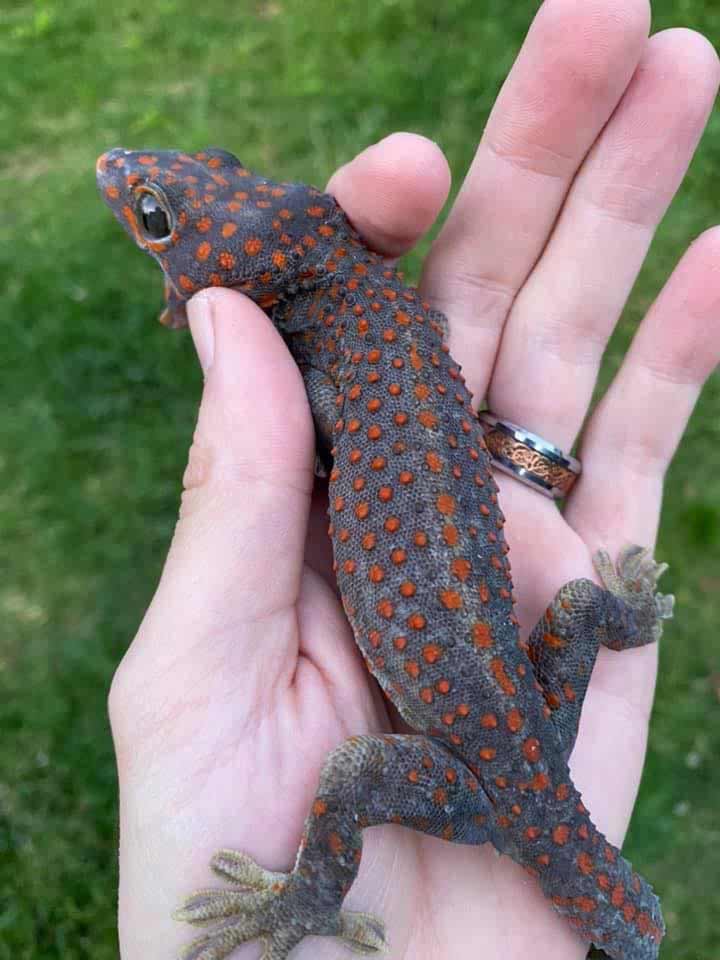
Candy morph. Photo by Joshua Carson
Since just like yellow spotteds, you can put a granite to a granite and end up with all normals that will never change, you need two granites of the same type caught from the same area to have a chance at producing any visuals at all, or you can try line breeding. So far what has been discovered about the gene is that it seems to be a simple recessive progressive trait. Which makes line breeding difficult, because you will have a visual paired to a heterozygous and you should be producing visuals and heterozygous but since they almost never hatch out visual you are stuck holding back everything for years hoping someone will start to change. Finally when looking at buying a leucistic tokay, remember that there is no true leucistic morph for tokays. The name leucistic tokay is just a sales gimmick used on imported white tokays. Most buyers do not realize that their newly purchased white tokay has a great chance of turning into a pied, granite, or reverting back to a normal colored tokay.
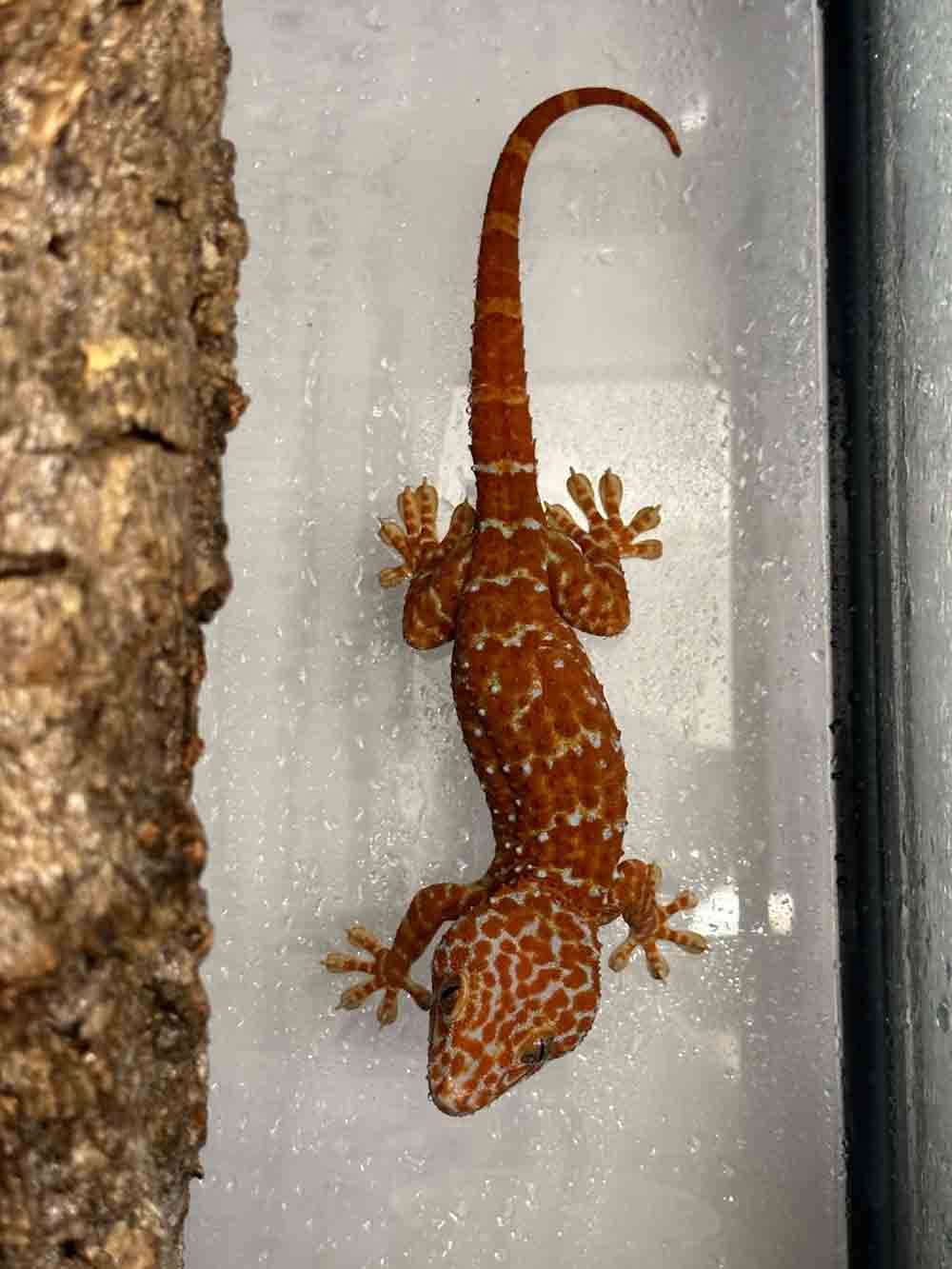
Super red tokay gecko morph. Photo by Jimmy Ma
Reduced Pattern: Probably the most readily available, underrated, and mislabeled tokay morph out there. As the morph name suggests the reduced pattern is a tokay with less pattern, but also has an off base color tending to be more of a green color. Reduced males tend to have more pattern or red spots than females. Due to the fact that some animals are virtually patternless, it becomes difficult to distinguish this morph from a patternless, especially females often get mislabeled as patternless to be sold at higher prices. One distinguishing feature is the presence of light blue banding on the body of the animal. The reduced morph is a codominant gene and is sometimes referred to as “Green Codominant.”
Albino: There have been a few amelanistic or albino animals that have come in as imports over the last few years. However, just like with other tokay morphs, just because two animals are phenotypically the same does not mean they will be genetically compatible. This is not unlike albino boa constrictors, with Kahl and Sharp lines not being compatible with each other but rather distinct lines of albinos. Similar to other reptiles, there are T+ and T- albinos. What is even more confusing is the fact that some importers/ exporters also use the term hypomelanistic interchangeably when labeling the animals. One way to distinguish true albinos is to look into their mouths. They should have no black in their mouth and should be entirely pink. Several breeders have been working with albinos and we do have proven lines of both T+ and T- albinos. So far all seem to be simple recessive. Kevin McCurley has proven and established a line of T- albino, while Joshua Carson has proven and established a line of T+ albinos. However, keep in mind that if you are buying a wild-caught imported animal labeled as “albino” it is considered an unproven gene until you can do the work of proving that it is a heritable trait and if it is compatible with other established lines.
Tokay Gecko Attacks Tree Snake, Which Regurgitates Another Gecko
Tokay Gecko Care
Diablo: Diablo is a morph that is characterized by a purplish undertone that can appear translucent at times. They have distinctive jet black eyes and spots that can go from a deep orange to a bright yellow. This morph seems to have been first proven simple recessive in Indonesia back in 2018. The project was further developed by Max Ong in Malaysia in 2019. We now have our first USCB examples of this morph thanks to the efforts of Logan Barret of M95 Genetics.
Conclusion
Tokay geckos have many qualities that make them ideal candidates for your next scaly pet. They can be extremely hardy as long as a few fairly simple conditions are met. They come in a variety of colors and pattern morphs. While their attitude might make the process of taming them more challenging, it is all the more rewarding when you do succeed in taming one down. Gone are the days of looking at tokay geckos as “cheap” imports and disposable pets. Over the last few years, there has been a surge in interest in keeping and breeding tokay geckos. Ideally, get yourself a captive bred animal. Imported animals, while they might be tempting, do require some additional considerations and care. Even then, sometimes, they might not do well. US captive born and bred tokays are highly sought after captives, especially those of various color and pattern morphs. While we now have a better understanding of genetics and inheritance of certain tokay morphs, there is still much to be discovered. As mentioned before, do your research if you are thinking about getting certain morphs of tokays. While many may look phenotypically the same, they might not be genetically compatible. It goes without saying that we have only scratched the surface. We hope that if you are looking for a gecko that has vibrant colors and a spunky attitude, you will consider getting a tokay gecko.
Jimmy Ma is the owner of Gekko & Gecko, LLC. He has been keeping reptiles for more than 20 years and is currently working with tokay gecko morphs and New Caledonia giant geckos. You can reach him on Instagram at @gekko_and_gecko. Joshua Carson is the co owner of CPX Reptiles with Mark Prieto. Joshua has morethan 15 years experience working with tokay geckos. CPX Reptiles works with tokay gecko morphs and unappreciated oddball reptiles. You can visit them on Facebook at CPX Reptiles.

